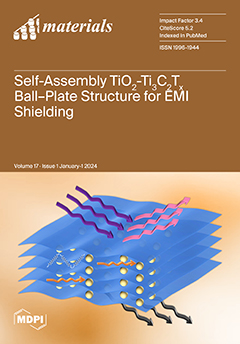Utilizing neodymium-based butadiene rubber as a baseline, this study examines the effect of eco-friendly aromatic TDAE oil, fillers, and crosslinking reactions on neodymium-based rare-earth butadiene rubber (Nd-BR) crystallization behavior. The findings suggest that TDAE oil hinders crystallization, resulting in decreased crystallization temperatures and
[...] Read more.
Utilizing neodymium-based butadiene rubber as a baseline, this study examines the effect of eco-friendly aromatic TDAE oil, fillers, and crosslinking reactions on neodymium-based rare-earth butadiene rubber (Nd-BR) crystallization behavior. The findings suggest that TDAE oil hinders crystallization, resulting in decreased crystallization temperatures and heightened activation energies (
Ea). The crystallization activation energies for 20 parts per hundreds of rubber (PHR) and 37.5 PHR oil stand at −116.8 kJ/mol and −48.1 kJ/mol, respectively, surpassing the −264.3 kJ/mol of the unadulterated rubber. Fillers act as nucleating agents, hastening crystallization, which in turn elevates crystallization temperatures and diminishes
Ea. In samples containing 20 PHR and 37.5 PHR oil, the incorporation of carbon black and silica brought the
Ea down to −224.9 kJ/mol and −239.1 kJ/mol, respectively. Crosslinking considerably restricts molecular motion and crystallization potential. In the examined conditions, butadiene rubber containing 37.5 PHR oil displayed no crystallization following crosslinking, albeit crystallization was discernible with filler inclusion. Simultaneously, the crystallinity level sharply declined, manifesting cold crystallization behavior. The crosslinking process elevates
Ea, while the equilibrium melting point (
) noticeably diminishes. For instance, the
of pure Nd-BR is approximately −0.135 °C. When blended with carbon black and silica, the
values are −3.13 °C and −5.23 °C, respectively. After vulcanization, these values decrease to −21.6 °C and −10.16 °C. Evaluating the isothermal crystallization kinetics of diverse materials via the Avrami equation revealed that both the oil and crosslinking process can bring about a decrease in
n values, with the Avrami index
n for various samples oscillating between 1.5 and 2.5. Assessing the dynamic mechanical attributes of different specimens reveals that Nd-BR crystallization notably curtails its glass transition, marked by a modulus shift in the transition domain and a decrement in loss factor. The modulus in the rubbery state also witnesses a substantial augmentation.
Full article






